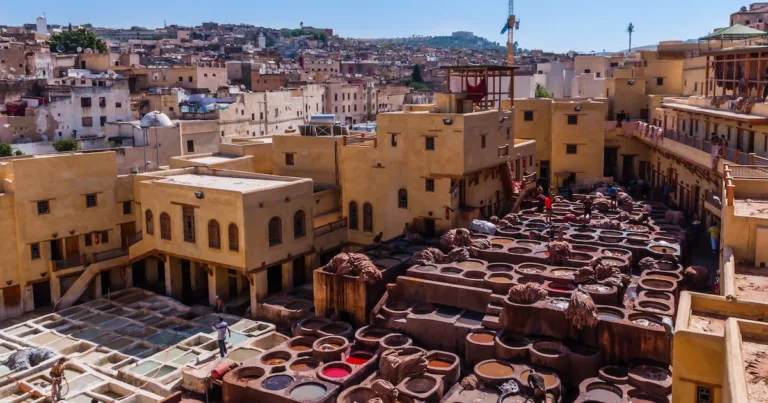If you’re curious about the leather industry, you may have heard of the term “tannery”. book a 3 days desert tour from marrakech. A tannery is a facility that transforms animal hides into leather by using various chemicals and processes. In this article, we’ll explore what tanneries are, how they operate, and their impact on the environment and society. read Weather in January in Morocco.
What is a Tannery?
A tannery is a place where animal hides are treated and transformed into leather through a process called tanning. Tanning is the process of turning animal skins into a stable material that is resistant to decomposition. Tanneries process animal skins by removing the hair and excess flesh, soaking the hides in chemicals, and drying and finishing the leather. read about Marrakech to Casablanca Train.
The History of Tanneries
Tanneries have been around for centuries, with the earliest records of tanning dating back to ancient Egypt. In those times, tanning was a labor-intensive process, with hides being soaked in water, then rubbed with oil or fat to prevent them from drying out. As technology advanced, new methods were developed to improve the efficiency and effectiveness of tanning.
Types of Tanneries
There are different types of tanneries, each specializing in specific types of leather. Some of the most common types of tanneries include:
- Vegetable Tanneries: These tanneries use natural tannins extracted from plants, such as bark and leaves, to transform the hides into leather. Vegetable-tanned leather is known for its durability and natural beauty.
- Chrome Tanneries: These tanneries use chromium salts to tan the hides. Chrome-tanned leather is soft, pliable, and has a uniform color.
- Combination Tanneries: These tanneries use a combination of vegetable and chrome tanning to produce leather with a balance of durability and pliability.
- Exotic Leather Tanneries: These tanneries specialize in the production of leather from exotic animals, such as alligators, snakes, and ostriches.
Tannery Operations
The tanning process involves several stages, including:
Pre-Tanning Stage
During the pre-tanning stage, the hides are sorted, trimmed, and soaked in water to remove dirt and blood. The hides are then de-haired and de-fleshed, and the remaining fat and tissue are removed.
Tanning Stage
After the pre-tanning stage, the hides are soaked in a tanning solution that transforms the hides into leather. The tanning solution can be made of different chemicals, depending on the type of leather being produced.
Post-Tanning Stage
Once the hides are tanned, they are washed, dried, and stretched. The leather is then graded and sorted based on quality.
Environmental Impact of Tanneries
Tanneries are known for their environmental impact due to the chemicals used in the tanning process. Some of the chemicals used, such as chromium and formaldehyde, are toxic and can cause pollution and health problems. However, many tanneries are implementing eco-friendly practices, such as using renewable energy sources, reducing water usage, and recycling waste.
Conclusion
In summary, tanneries play a significant role in the leather industry, transforming animal hides into leather through a process called tanning. There are different types of tanneries, each specializing in specific types of leather. Tannery operations involve several stages, including pre-tanning, tanning, and post-tanning. Tanneries can have a negative impact on the environment, but many are implementing eco-friendly practices to minimize their impact.
FAQs
What is the difference between vegetable-tanned and chrome-tanned leather?
Vegetable-tanned leather is made using natural tannins extracted from plants, such as bark and leaves. It is known for its durability, natural beauty, and ability to develop a patina over time. In contrast, chrome-tanned leather is made using chromium salts, which create a soft, pliable leather with a uniform color.
Are tanneries harmful to the environment?
Tanneries can be harmful to the environment due to the chemicals used in the tanning process. However, many tanneries are implementing eco-friendly practices to reduce their environmental impact.
Are tanneries still relevant in today’s society?
Yes, tanneries are still relevant in today’s society, as leather remains a popular and versatile material used in many industries, such as fashion, automotive, and furniture.
Can I visit a tannery?
Some tanneries offer tours or visits, but it’s best to check with the individual tannery to see if they allow visitors and what safety precautions may be necessary.
In conclusion, tanneries are a vital part of the leather industry, transforming animal hides into durable and versatile leather products through the tanning process. While there are concerns about the environmental impact of tanneries, many are taking steps to minimize their impact and promote sustainability. As consumers, we can also make more informed choices about the leather products we buy, looking for eco-friendly materials and certifications that prioritize sustainability.
